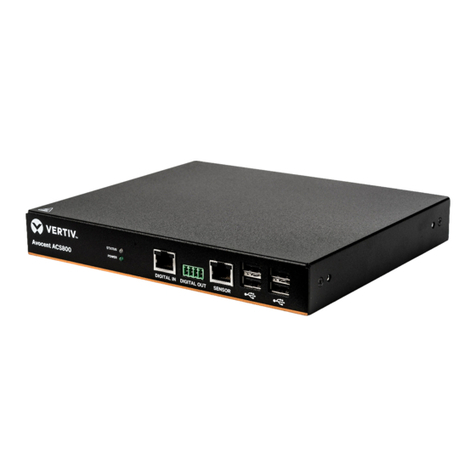
1 INTRODUCTION
The Avocent® ACS800/8000 Advanced Console Server serves as a single point for access and administration of connected
devices, such as serial consoles, modems and power devices. The console server supports secure remote data center
management and out-of-band management of IT assets from any location worldwide.
NOTE: Unless noted, references to a console server refer to all models in the 800/8000 series.
The console server provides secure local (console port) and remote (IP and dial-up) access. The console server runs the
Linux® operating system with a persistent file system in Flash memory that can be upgraded with a local file on a computer
connected to the console server.
Multiple administrators can be logged into the console server at the same time and can use the web user interface (web UI),
the Command Line Interface (CLI utility) or DSView™ 4 management software to access and configure the console server.
NOTE: Unless otherwise noted, all references to DSView software in this document refer to version 4 or greater.
Depending on the model, the console server has either four or eight USB ports to support modems, storage devices, network
adapters, USB hubs and USB console devices. Some models have an SDcard slot to support an additional storage device.
Two network ports support connections to more than one network, or can be configured for Ethernet bonding for redundancy
and greater reliability or network failover support.
For dial-in and secure dial-back with Point-to-Point Protocol (PPP), an optional internal modem can be factory installed or
you can use an external modem connected to either a serial or USBport.
1.1 Features and Benefits
1.1.1 Access options
Secure access is available through the following local (analog console port) and remote (digital IP and dial-up) options:
•LAN/WAN IP network connection.
•Dial-up to a factory-configured internal modem (optional) or a modem connected to one of the serial or
USBports.
•Target device connection. An authorized user can make a Telnet, SSH v2 or Raw connection to a target
device. For Telnet or SSH to be used for target device connections, the Telnet or SSH service must be
configured in the Security Profile that is in effect.
•Console system console connection. An administrator can log in either from a local terminal or from a computer
with a terminal emulation program that is connected to the console port and can use the CLI utility. The CLI
utility prompt (--:- cli->) displays at login.
More than one administrator can log into the console server and have an active CLI or web UI session. All sessions receive
the following warning message when the configuration is changed by another administrator or by the system: The appliance
configuration has been altered from outside of your session. Upon receipt of this message, each administrator needs to verify
that changes made during the session were saved.
1.1.2 Web user interface (web UI)
Users and administrators can perform most tasks through the web user interface (web UI), which can be accessed with
HTTP or HTTPS. The web UI runs in Microsoft® Internet Explorer®, Microsoft® Edge®, Mozilla® Firefox®, Google® Chrome®
and Apple® Safari® on any supported computer that has network access to the console server. The list of supported client
browsers and their versions are available in the release notes.
1





























